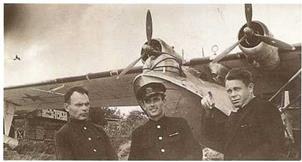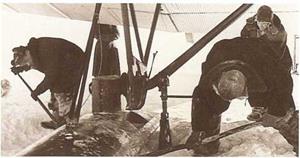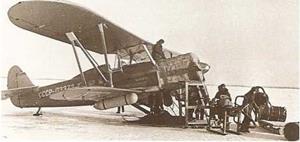The Great Patriotic War
Mobilization
With shattering force, and with the element of surprise, Hitler’s Germany launched Operation Barbarossa and invaded the Soviet Union on 22 June 1941. Within two or three days, at least half of the Soviet Air Force had been destroyed before the aircraft could take to the air. All Aeroflot services to the west were immediately suspended — including the one to Berlin! — but those to the east continued for a while, as did some of the routes of Aviaarktika. On 25 June, Grazdansij Vozduzhnij Plot (Aeroflot) effectively became a unit of the Soviet Air Force. Vasily S. Molokov, hero of the Chelyuskin rescue, and veteran of Polar aviation, was appointed head of the military transport organization, with the rank of Major-General.
The Battle of Moscow
In October 1941, the Germans made a concentrated effort to capture Moscow. The Soviet forces desperately defended their capital. On 16 October, the Government transferred to Kuibyshev (Samara), although Stalin himself (in an uncharacteristic reflection of a similar decision by King George VI) stayed in Moscow. Aeroflot was directly involved in the defense of Moscow. The published statistics were impressive: 32,730 flights (845 behind enemy lines); 49,822 troops carried; and 1,365 tons of supplies, arms, and medicines carried.
Organization
Late in 1942, two special groups were formed: the First Transport Aviation Group (renamed in 1944 as the 10th
|
|
Guards Aviation Division); and the Special Communications Aviation Group (later to become the 3rd Communications Aviation Division). The fleets were composed of the former aircraft of Aeroflot, plus a number of obsolete types no longer useful as military equipment, such as the TB-3 (ANT-6) four-engined bomber, designed back in 1930, but still useful as a load-carrier. Additionally, 15 Detached Aviation Regiments were formed in 1943. Equipped with Poiikarpov U-2/Po-2s, these units were highly mobile, providing close support to individual regiments at the front line, with ambulance, reconnaissance, and communications missions.
Reinforcements
With their backs to the wall in 1942 and the early part of 1943, the Soviet armed forces gladly accepted any help they could get, from whatever source. Paramount among such efforts was the American Lend-Lease program, and among the thousands of aircraft ferried from the east (see opposite) were hundreds of Douglas C-47s, which were promptly delivered to the First Detached Aviation Division, for operations on the Central Front, where they were joined by their matching twins Lisunov Li-2s, manufactured at Tashkent under a DC-3 license from Douglas, negotiated through AMTORG.
Other help to augment the meager resources of Aeroflot during the desperate conflict came from an unexpected source. Between 31 January and 2 February, the city of Stalingrad was the site of one of the greatest victories of the Great Patriotic War — or of any war. During the final days of the doomed German armies, they had been supplied by a large number of Junkers-Ju 52/3m transports. About 80 of
The Lisunov Li-2 was the transport workhorse for the Soviet Union during the Great Patriotic War. (photo: Boris Vdovienko)
|
|
|
|
In the Arctic, aircraft frequently stuck in the snow when icing effectively glued them to the runway. Such scenes as this were familiar in the north. The aircraft is an ANT-7, (photo: Boris Vdovienko) these abandoned ‘Tante Ju’s’ were repaired and put into service with Aeroflot.
A Great War Record
The Great Patriotic War ended on 9 May 1945. Aeroflot’s contribution to the war effort had been considerable, and was so recognized: 15,000 of its staff received medals and honors; 15 pilots were proclaimed Heroes of the Soviet Union; six of the Front-line Sections became Guards Units; and ten Sections were awarded special medals. They had been well earned. During the War, Aeroflot had carried 2,300,000 passengers and 300,000 tons of freight, including materiel and medical supplies. Of the passengers, 330,000 were wounded soldiers.
|
|

A Soviet Navy GST (license-built Consolidated 28 Catalina) at Khabarovsk in the early 1940s. The military GST was also used for passenger transport along with a few civil versions (designated MP – 7) built for Aeroflot. The pilot on the right is Mikhail Vodopyanov, (photo: Far Eastern Regional Directorate Museum, Khabarovsk)
A Poiikarpov U-2 (Po-2), diminutive maid-of-all-work, was to be seen everywhere during the War. This Aeroflot U-2 (SSSR-L3373) pictured at Tobolsk in 1941 has a sliding canopy enclosed cockpit- for the pilot, and three passenger windows in the fuselage and containers underneath the wings, (photo: Boris Vdovienko)














